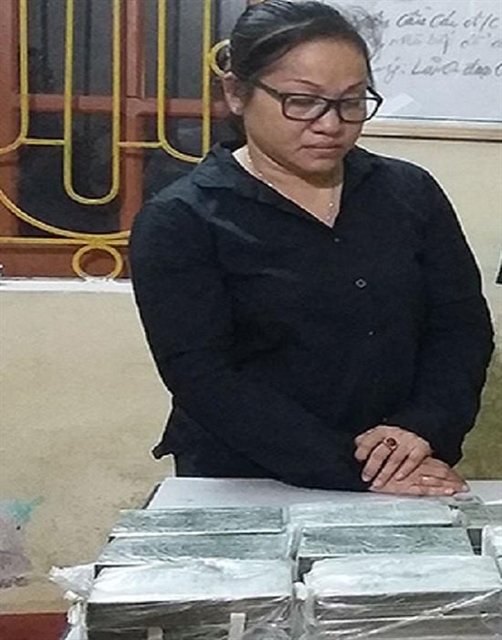 |
|
Đào Thị Hải, 51, from Lê Chân District, Hải Phòng City has been sentenced to death for illegal drug transportation. — Photo zing.vn
|
A woman was sentenced to death by the People's Court of northern Hải Dương Province on Tuesday after she was caught transporting more than 10 kilos of heroin, news.zing.vn reported.
Đào Thị Hải, 51, from Lê Chân District, northern Hải Phòng City was stopped by police with 30 packages of the drug in her car at Hải Dương Province's Tứ Kỳ District on May 20.
Twenty six were hidden in two bags of rice and a further four packages in a backpack.
Hải claimed she was paid VNĐ20 million (US$850) by an unknown man to take the drugs from northern Thái Bình Province.
Her son, who was driving the car at the time, was unaware of they were carrying narcotics.
Hải Dương People’s Court was told the woman had previous criminal convictions for drug use, organising gambling, gambling and not denouncing criminals.
Lâm Đồng investigates forest destruction
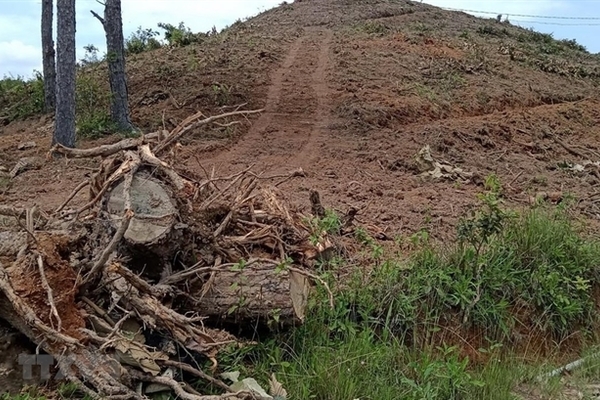 |
|
Pine trees were chopped down in Nam Hà Commune, Lâm Hà District in the central highland province of Lâm Đồng.
|
A joint investigation between police and officials has been carried out into the destruction of a pine forest in Lâm Hà District.
It follows reports by Vietnam News Agency revealing hundreds of pine trees had been chopped down to make way for a coffee plantation in Nam Hà Commune.
An inspection team from the police department and the People’s Procuracy of Lâm Đồng Province’ Lâm Hà District has worked with local forest protection management board to get to the bottom of the problem.
The inspection team has checked two areas that 20-years-old pine trees were chopped down on Monday.
The area was under the management of the Forest Protection Management Board.
Previously, in 2018, ancient pine trees on an area of nearly 3,000 square metres were also chopped down in the area.
On Monday morning, chairman of Nam Hà Commune’s People’s Committee Tiêu Văn Bính showed reporters the area.
He said the Sub-area 261B had been the hot spot of deforestation and forest encroachment for years.
The committee had mobilised rangers to patrol the forest, but the work had so far not been effective.
The committee had reported the incident to the district’s authority.
Vietnam named as Miss Charm International host

The organising board of Miss Charm International announced Vietnam as the host of the beauty pageant’s debut contest during a press conference held in Ho Chi Minh City on October 8.
A number of famed Vietnamese beauties took part in the event, including Huyen My, who finished in the Top 10 of Miss Grand International 2017, and Thuy Dung, who finished as the second runner-up of Miss Vietnam 2016. The pair were joined by Lan Khue, Miss Ao Dai Vietnam 2015, Le Au Ngan Anh, Vietnam’s representative at Miss Intercontinental, and Mai Ngo, the runner-up at The Face Vietnam 2016.
Miss Charm International, a recently founded international beauty pageant, is being organised by the Hong Kong-based Miss Charm International Organization.
For the contest’s first edition in 2020, the beauty pageant is expected to have contestants from between 40 to 50 participating countries.
The pageant aims to honour the beauty of the soul, intelligence, talent, in addition to the physical beauty of women worldwide. The event marks a golden opportunity for contestants to popularise their land, people, cuisine, and promote tourism to international friends through the range of activities taking place throughout the competition.
In recent years, Vietnam has produced several contenders at global beauty pageants. Notable examples include Lan Khue who finished among the Top 11 of Miss World 2015, Thuy Van who finished as the third runner-up of Miss International 2015, Nguyen Thi Loan who finished in the Top 20 of Miss Grand International 2016, and Huyen My who was named among the Top 10 of Miss Grand International 2017.
Law on Handling Administrative Violations needs to be rationalised: conference
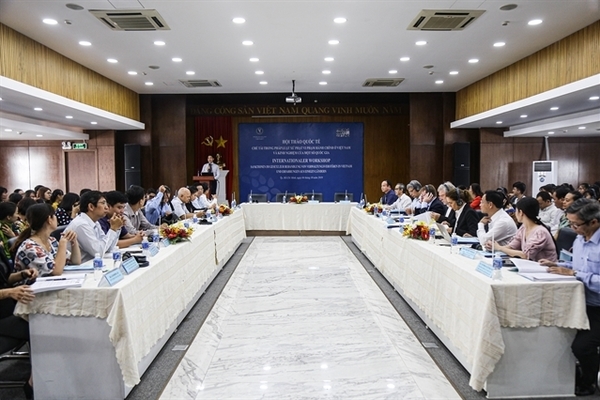
Shortcomings and amendments are discussed at a conference held by the HCM City University of Law in in the city yesterday.
The Government has issued nearly 100 decrees to punish civil offences, and many overlap, making it difficult for authorities to enforce them, a conference heard in HCM City last week.
According to Assoc Prof Dr Nguyễn Cảnh Hợp, vice chairman of the HCM City University of Law’s training and science council, the regulations on handling administrative violations are also too complicated.
Besides, many of the penalties prescribed are not commensurate with the dangers a violation poses.
For instance, spreading nails on the street merely attracts a fine unless it causes death or severe injury.
If builders do not put up a warning notice or cover holes at construction sites, it is treated as a minor violation though it could lead to the death of many people.
Agencies currently involved with amending the 2012 Law on Handling Administrative Violations should comprehensively reform it, Hợp said.
Other delegates said penalties were not consistent though the violation might be the same.
Many parties were repeatedly penalised and even temporarily shut down for offences, but they were always back without fear of severe sanctions, they said.
Fines for many violations were low, they said, pointing to the VNĐ100,000-200,000 hawkers pay on banned streets, and the VNĐ100,000-300,000 prostitutes have to pay.
They said the fines should be based on the possible consequences to deter violations.
The conference was organised by the university together with Germany’s non-profit Friedrich Ebert Stiftung to collect opinions from foreign and Vietnamese experts for amending the law.
Quang Tri: Wildlife trafficker arrested, five pangolins rescued
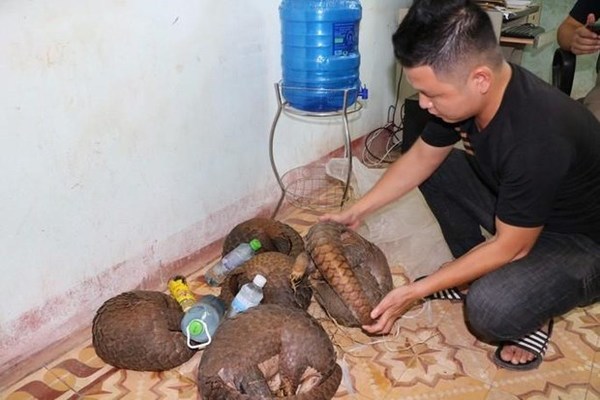 |
|
The rescued Java pangolins
|
Police in the central province of Quang Tri’s Huong Hoa district on October 7 arrested a man illegally transporting five Java pangolins, which are in the list of endangered rare species and banned from trading.
Tran Quang, 61, residing in Huong Hoa district, was detected carrying a woman with many suspicious signs. When asked to stop for checking, Quang drove his motorbike to flee. After being chased nearly 2 km, the woman jumped off the motorbike and fled into a coffee field.
Quang was found to transport the five Java pangolins with total weight of 32.7 kg.
Quang admitted that he was rented to transport the pangolins, which are estimated to value about 250 million VND (10,780 USD), from Tan Lien commune to Khe Sanh town.
The local police are searching for the fleeing woman for further investigation.
On October 8, staff from the Vietnam Wildlife Protection Centre under the Cuc Phuong National Park came to Huong Hoa district to rescue these pangolins./.
Centuries-old village turns to smart tourism
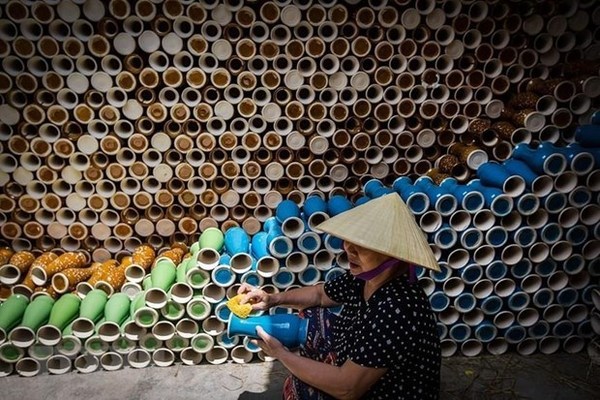 |
|
Bat Trang is one of the most famous pottery villages in Vietnam.
|
As part of a new initiative, smart tourism will be applied at the centuries-old Bat Trang commune in Gai Lam district on the outskirts of Hanoi.
Now, old kilns, ancient houses and pottery workshops will be ready to receive a new wave of tourists.
The ceremony introducing Bat Trang commune as a tourist site will take place on October 9. A cultural festival will be held on October 9-13, with various activities to promote the tourism potential of the village. Art performances will also take place during the festival.
Bat Trang commune, comprising Bat Trang and Giang Cao villages, is an attractive destination for tourists, especially foreigners. People come to try making pottery and buying ceramics. However, there are many things about the village that visitors don’t know.
The Hanoi Department of Tourism, in collaboration with the Gia Lam district People’s Committee, plans to develop Bat Trang commune as a tourist site.
Bat Trang commune is home to beautiful old houses, temples, pagodas and pottery kilns. They are set along different routes for tourists to discover.
A tourist information centre is being established to introduce visitors to the site and provide other services, including an audio tour in 12 languages.
The authorities are also offering tourism services on smart devices, free wifi, virtual reality experiences, electric cars, culinary tours and bicycle hire.
Ly Duy Thanh, Vice Chairman of the Gia Lam district People’s Committee, said local authorities have tried to develop tourism in recent years. But now the services are being deployed professionally to bring wonderful experiences to tourists and develop sustainable tourism.
“We have brought a CNN film crew to Bat Trang commune to introduce this tourist site to the world, we also connect travel companies and local people regularly to lure more tourists,” he said.
Ha Van Lam from Bat Trang village said all locals are willing to receive tourists.
“We try to preserve ancient houses and kilns to make them beauty spots. Actually, all villagers use gas and electricity to make pottery. We no longer use charcoal to protect the environment and reduce smoke and dust.”
“We receive 2,000-3,000 guests each day including big groups of students,” he said.
“People often visit the central market to buy ceramic items and learn to make pottery at some workshops, but they don’t know that Bat Trang has many more things to discover. For example, Tieu Dao Pagoda and the Mother Goddess Temple still have many worship objects and statues dating from the 10th century.”
“Following the plan by the People’s Committee and Department of Tourism, we will establish some households to serve food and accommodation for tourists. Previously, tourists just spent half a day at the site,” said Lam./.
600 artisans to join second Thai ethnic cultural festival
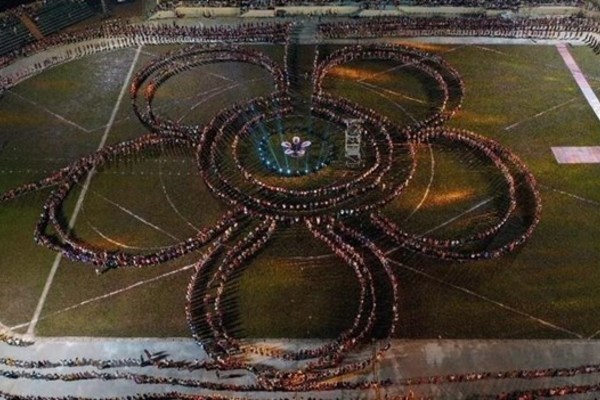 |
|
600 artisans to join second Thai ethnic cultural festival hinh anh 1"Mua xoe", a traditional dance of Thai ethnic people
|
As many as 600 artisans and artists from Thai ethnic groups of Son La, Lai chau, Yen Bai, Thanh Hoa and Dien Bien provinces are expected to join the second Thai ethnic cultural festival in
Dien Bien from October 18 to 20.
The information was revealed by Director of the Department of Ethnic Culture under the Ministry of Culture, Sports and Tourism Nguyen Thi Hai Nhung at a press conference in Hanoi on October 8.
The event aims to preserve and promote the Thai unique culture in the period of national integration and development.
Various cultural, sport and tourism events will be held such as performing Thai ethnic traditional costumes, introducing cultural activities of Thai ethnic groups, and promoting local tourism products.
Visitors can also learn about Thai ethnic groups’ brocade weaving skills and take part in folk games such as walking on stilts, crossbow shooting, and tug of war.
Particularly, visitors will have an opportunity to enjoy “mua xoe”, a traditional dance of Thai ethnic people, which has been recognised as national intangible cultural heritage by the Ministry of Culture, Sports
and Tourism./.
JICA funds project to improve VN’s capacity for water environment management
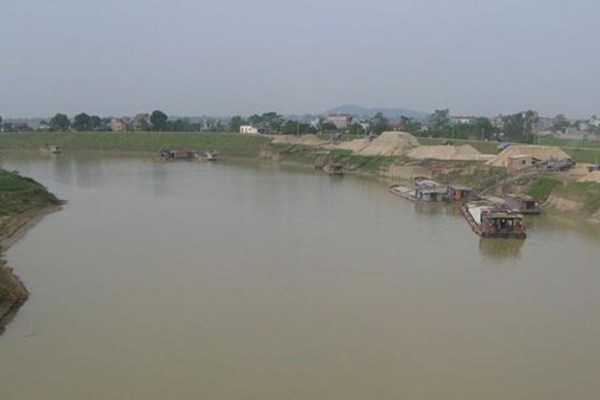
The Japan International Cooperation Agency (JICA) will provide technical assistance worth 914,000 USD to a project to improve Vietnam’s capacity for water environment management.
Under the project, which was launched by the Vietnam Environment Administration (VEA), JICA and Japanese-based Optex Company Limited on October 8, simple water monitoring devices will be installed
at 54 points in provinces in the Cau River basin which are Bac Kan, Thai Nguyen, Bac Ninh, Bac Giang, Vinh Phuc and Hai Duong provinces and Hanoi city. The project aims to assess those devices’
efficiency, suitability for the local environment and their satisfaction of techniques and measurement regulations in Vietnam.
The project will be carried from October 2019 to September 2020.
VEA Deputy Director Nguyen Hung Thinh said that environment monitoring has been maintained in Vietnam since 1994, and it has played an increasing role in environmental protection and management in the country.
He laid stress on the importance to enhance water monitoring activities in river basins as socio-economic development is exerting great pressure on the water resources.
Daisuke Okabe, a representative from the Japanese Embassy in Vietnam, said that the Cau River basin is suffering from serious pollution, and the project’s equipment, which is able to collect the monitoring data easily at low cost, is expected to assist with the control of water quality in the basin.
Meanwhile, Koji Takauchi, a senior consultant at JICA, believed the project will solve problems of water quality in Vietnam’s river basins based on products that have been successfully applied in Japan./.
Hanoi seeks friendship ambassador for peace
 |
|
At the launching ceremony (Source: hanoimoi.com.vn)
|
The Hanoi Union of Friendship Organisations (HUFO) and partners on October 8 launched a contest to select a friendship ambassador for peace.
The event forms part of activities marking 20 years since Hanoi was recognised as “City for Peace” by UNESCO and the 65th anniversary of the capital city’s liberation from French colonial regime.
Addressing the launching ceremony, Tran Thi Phuong, HUFO Vice President, said organisers hope that each contestant will be an ambassador who helps to spread messages and actions for peace.
The event wants to honour cultural and artistic values through the costumes and performances of contestants, comprising Vietnamese at home and abroad, and foreigners living and studying in Hanoi, she said.
The contest also aims to intensify solidarity and friendship between Hanoians and international friends, and promote the city’s image to the world, Phuong added.
Forty females and 13 males have registered for the contest, with the final round slated to be held in mid-November 2019.
Right after the launching ceremony, the contestants participated in some activities like presenting gifts to disadvantaged people in the city.
The contestants, aged between 18 and 50, will present essays, photos and video clips whose contents support the friendship between countries.
Notably, foreign candidates will be exempted from the qualifying round, and get extra marks if they can prove their Vietnamese language skills and understanding about Hanoi./.
2019 Career Day for young people
This year’s fair attracted thousands of young people, especially overseas students returning to Vietnam and nearly 40 employers. Even though these graduates are considered to have an advantage over domestic bachelors in terms of foreign languages and experience, finding a suitable job is still an obstacle for them.
Although the career fair is geared towards for students who used to study overseas, domestic graduates also find them the opportunity to have direct access to large businesses in many different fields. Many bachelors and even undergraduates come to look for their opportunities in this fair.
This event not only provides employers with potential employees but speakers also guide young people on how to find a path that matches their passion, find their strengths and the demands of the market./.
Ancient pagoda in Nam Dinh recognised as national cultural heritage
 |
|
Keo Hanh Thien Pagoda is one of the most ancient pagodas in Vietnam whose architecture has been preserved intact over its 400 year-old history. — (Source: vuanhiepanh.com)
|
Over-400-year-old Keo Hanh Thien Pagoda in the northern province of Nam Dinh has been recognized as a national intangible cultural heritage.
Over-400-year-old Keo Hanh Thien Pagoda in the northern province of Nam Dinh has been recognized as a national intangible cultural heritage.
A ceremony was held in Xuan Truong district on October 8 to receive the recognition and also kick off the Keo Hanh Thien Pagoda Festival 2019.
According to Tran Le Doai, Vice Chairman of the provincial People’s Committee, the ancient pagoda, which dates back to the Ly Dynasty (1009–1225), was a space for villagers to pay tribute to Zen master Duong Khong Lo, who significantly contributed to the development of the Vietnam Buddhist Sangha during the Ly Dynasty.
“The National Intangible Cultural Heritage recognition will promote the historical, cultural and architectural values of Keo Hanh Thien Pagoda,” he said.
State management on preserving, protecting and promoting the values of the festival must be tightened to make it an attractive destination, which would help to boost local tourism, he added.
Legend has it the pagoda was originally built in bronze by Duong Khong Lo along the banks of the Red River in 1061 during King Ly Thanh Tong reign.
It was initially known as Nghiem Quang Tu and then renamed Than Quang Tu in 1167. It was also known as Keo Pagoda following the Chinese-transcribed Vietnamese name for Giao Thuy district.
After standing for nearly 500 years, the Red River flooded Giao Thuy village where the pagoda was located in 1611. The villagers relocated to establish Hanh Thien Village and built a new pagoda.
It is one of the oldest pagodas in Vietnam, covering 58,000sq.m in Xuan Truong district's Xuan Hong commune.
Many ancient historical items dating back to the 17th century are still being preserved in the pagoda such as altars, bells, and Han-scripted books about the pagoda.
The Keo Hanh Thien Pagoda Festival, which includes traditional ceremonies, folk games and a boat race, will end on October 14./.
Quang Tri mobilises over 65.6 trillion VND for rural area building

The central province of Quang Tri has mobilised a total of 65.63 trillion VND (2.82 billion USD) for building new-style rural areas over the past decade, the provincial steering board for national target programmes reported.
As of October 2019, 52 out of the province’s 117 communes have been recognised as new-style rural areas. The number is projected to reach 60 at the end of this year.
Three out of eight pilot communes, comprising Vinh Thuy and Vinh Kim in Vinh Linh district, and Cam Chinh in Cam Lo district, have won the status of model new-style rural areas.
The programme has helped to improve rural infrastructure, thus better meeting demands of production and daily activities, while spurring the rural economy.
According to the steering board, Quang Tri aims to have 6-8 communes and one district recognised as new-style rural areas, and each district having at least a model new-style rural area in 2020.
To that end, the locality will prioritise production under value chains, especially safe agricultural production, thus contributing to the restructuring of labour and rural economy.
At the same time, Quang Tri will step up environmental protection, focusing on green and clean hamlets in service of community-based tourism.
The National Target Programme on New-style Rural Area Building, initiated by the Government in 2010, sets 19 criteria on socio-economic development, politics, and defence, aiming to boost rural regions of Vietnam.
The list of criteria includes the development of infrastructure, the improvement of production capacity, environmental protection, and the promotion of cultural values.
Gender equality helps reduce sex imbalance at birth: official
Raising public awareness of gender equality as well as improving status of women and girls are considered as keys to reduce the unbalanced sex ratio at birth.
Raising public awareness of gender equality as well as improving status of women and girls are considered as keys to reduce the unbalanced sex ratio at birth, said Deputy General Director of the General Office for Population - Family Planning Nguyen Thi Ngoc Lan on October 8.
At a meeting held on October 8 in response to the International Day for the Girl Child (October 11) in the northern mountainous province of Lang Son, Lan stressed gender imbalance at birth, with more boys than girls being born, is increasing rapidly in both rural and urban areas across the country.
Currently, the rate is around 114.8 boys/100 girls, with Lang Son province recording a higher figure of 116.3 boys/100 girls in 2018, she said.
The imbalanced sex ratio at birth will negatively affect Vietnam’s population structure in the future, resulting in an excess of men. If there is no timely measure put in place, 2.3 - 4.3 million men in Vietnam will have no chance to find wives by 2050, Ngoc underlined.
Besides, the imbalance could have grave consequences for the country’s socio-economic development as well as the lives of women, men, families and communities.
A shortage of women also causes an increase in women’s early marriage, prostitution, trafficking of women and girls, and domestic violence against women, among others, she added.
Lan expressed her belief that with drastic efforts from competent sectors and branches and the whole community, gender imbalance at birth will be improved, bringing a brighter future to Vietnamese women and girl children.
After the meeting, a wide range of activities and parade in response to the International Day for the Girl Child were organised on Lang Son city’s streets./.
Programme helps poor students pursue study
 |
|
The “Vi em hieu hoc” programme has presented 125,000 scholarships worth 125 billion VND (5.37 million USD) to studious pupils in disadvantaged communes nationwide since it was launched in 2014. (Source: baosoctrang.org.vn)
|
The “Vi em hieu hoc” (Because you are studious) programme has presented 125,000 scholarships worth 125 billion VND (5.37 million USD) to studious pupils in disadvantaged communes nationwide since it was launched in 2014.
Under the programme, 2,510 scholarships valued at 2.15 billion VND (92,570 USD) were granted to students in the Mekong Delta province of Soc Trang, heard a meeting held in the locality on October 8.
The ten-year programme is jointly carried out by the Viettel Military Industry and Telecoms Group (Viettel), the Ministry of Education and Training, Radio The Voice of Vietnam and the Vietnam Study Encouragement Association.
Apart from scholarships, Viettel has provided free cardiac and oral surgeries for children in localities, built houses and presented cows, saving books and gifts to residents in remote, border and island areas.
On this occasion, the group presented 90 scholarships, each worth 1 million VND (43 USD), to needy students in Ke Sach district, Soc Trang province.
It aims to grant scholarships valued at 430 million VND (18,500 USD) to students in underprivileged communes in Soc Trang this year./.
US-funded sub-project aims to protect eco-diversity in Thua Thien-Hue
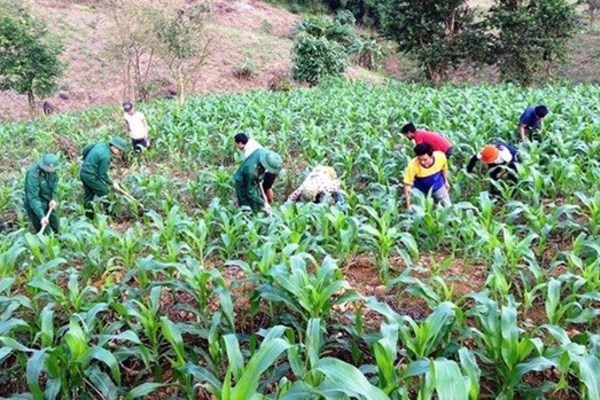
A sub-project funded by the US Agency for International Development (USAID) was launched in the central province of Thua Thien-Hue on October 8 to enhance conservation of local eco-diversity.
The scheme, to be implemented in three districts of Nam Dong, Quang Dien and A Luoi from September 2019 to September 2020, will help create sustainable livelihoods for local residents, thus reducing the exploitation of wildlife.
With a total budget of over 26.7 billion VND (more than 1.15 million USD), the sub-project will provide locals with techniques in exploiting rattan in a sustainable manner, and in cultivating medicinal herbs.
Local cooperative groups will also receive training to increase their capacity in doing business in handicrafts trading. Three centres will be built to showcase handicraft products from the target districts.
The sub-project, part of the USAID’s Green Annamites Project, is expected to create direct income for around 280 people.
Vo Van Du, head of the province’s Green Annamites Project management board, said through creating stable livelihoods for local residents, the sub-project will help reduce human’s pressure on nature, thus contributing to bio-diversity protection. It will also play a role in promoting the One Commune One Product and new-style rural area building programmes in the province.
The USAID’s Green Annamites Project, running from 2016-2020, is designed to help the central provinces of Quang Nam and Thua Thien-Hue improve people’s incomes by promoting investment in climate smart agriculture while at the same time conserving Vietnam’s natural forests and biodiversity./.
Dak Nong mobilises 91 trillion VND for new-style rural building
The Central Highlands province of Dak Nong has spent over 91 trillion VND (3.9 billion USD) on the national target programme on new-style rural area building during the 2010-2019 period, according to the provincial People Committee.
At its meeting last week to review the 10-year implementation of the programme, the committee set targets for the locality’s new-style rural area building in the next five years, with three districts expected to be recognized as new-style rural areas in the 2021-25 period.
Chairman of the committee Nguyen Bon said developing infrastructure and promoting effective farming models as well as linkages between production and consumption of agricultural products will be strengthened to realise the targets.
“We need to focus on helping poor households escape from poverty and improve their lives, especially ethnic minorities,” he said.
The implementation of the programme during 2010-20 period resulted in 16 of the province’s 61 communes recognized as new-style rural areas. Transport infrastructure, electric and water supply systems, schools and medical facilities have improved significantly and issues related to culture and sport development as well as environmental protection have been addressed.
However, shortcomings still existed, including campaigns to raise public awareness, said Le Trong Yen, Director of the provincial Department of Agricultural and Rural Development.
“Difficulties in mobilizing capital resources and a lack of State capital have also created challenges for implementation,” he said.
In addition, some poor households continued to rely on support from the State and community, and have not been proactive in trying to escape from poverty, he added.
Forty local collectives, nine households, and 14 individuals received certificates of merit for their significant contributions to building new-style rural areas in the province./.
Hai Duong needs 35 trillion VND for new-style rural area building
The Red River Delta province of Hai Duong aims to have 20 percent of its communes recognised as advanced new-style rural areas during the 2021-2025 period.
Besides, 10 percent of the communes are expected to win the status of model new-style rural area.
At least two districts in the province will meet criteria for a model new-style rural area and per capita income in rural areas is set at 55 million VND (2,365 USD).
To that end, Hai Duong needs to mobilise more than 35 trillion VND (1.5 billion USD) for the programme, of which nearly 9 trillion VND (387 million USD) will come from the State budget and 20 trillion VND (860 million USD) from credit loans.
As of September this year, 190 out of the 220 communes in Hai Duong had been recognized as new-style rural areas, reaching 96.3 percent.
A further 11 communes, three districts and a city are expected to receive the same recognition by the end of this year.
Average per capita income in rural areas has reached 42.8 million VND annually, up 14.2 million compared to 2015. Meanwhile, the rate of poor households has dropped to 2.53 percent, while 91 percent of locals have health insurance, up 15 percent over 2015.
Since 2010, Hai Duong has mobilised over 44.4 trillion VND for the programme./.
Digitisation of healthcare sector, a double-edged sword
 |
|
Digitisation of the healthcare sector is important to better serve patients, but hacking by cybercriminals is a grave risk, and great efforts are needed to keep patient information secure. — Photo tuyengiao.vn
|
The development of technologies such as 4G, 5G, internet of things and artificial intelligence has rapidly changed the healthcare sector’s landscape globally, including in Việt Nam, with more organisations adopting digitisation, according to experts.
The goal is to have multiple affiliated organisations sharing patients’ digitised medical records to provide more holistic healthcare.
Many healthcare institutions are also using smart equipment to carry out conventional tasks. For example, various devices measuring vital signs today are directly connected to the hospital’s systems. Once measurements are taken, the data is incorporated directly in the patient’s medical records without the need for manual intervention.
New technologies have enabled the healthcare industry to carry out remote operations. For instance, earlier this year, a surgeon in China successfully carried out an operation remotely.
Digitisation across the healthcare industry has helped service providers improve the quality of care and accelerate medical breakthroughs for better patient outcomes and mitigate the rising cost of healthcare.
The Vietnamese Government is also supporting the digitalisation of healthcare, launching projects to encourage and enable digital health solutions to be adopted around the country.
According to the Ministry of Health, all healthcare establishments will complete digitisation of medical records by 2030.
According to the Australian Trade and Investment Commission (Austrade) Việt Nam, Việt Nam’s economic growth, health-conscious population and fast-developing 4G and 5G infrastructure provide the perfect environment for digital health solutions.
There is strong interest in telemedicine and advanced technologies and systems that can improve decision making, improve operational efficiency and enhance patient care and experience, it said.
Yeo Siang Tiong, general manager of Kaspersky Lab Southeast Asia, said most hospitals were in the first stage of digital transformation, digitising simple data such as patient records, personal information, past diagnosis, and medicine.
But the digitisation of the healthcare industry had led to a massive increase in the number of targeted attacks against the sector, he said.
“The healthcare sector tracks a person’s medical history, personal information, sometimes they also track who their parents are, and genetic conditions that pass down from parents to child.
“Some of this information is actually worth more than a bank card.”
In addition, "the sector is less protected than sectors such as banking and finance," he said.
In the healthcare industry, cyber security should not be taken slightly because any issue could be a matter of “life and death,” he warned.
“What would happen when you need to treat a patient in an emergency room, but the information is suddenly not available. It is a life and death situation. It is actually very dangerous.”
At a recent conference on cybersecurity in the healthcare sector, experts said the consequences of a breach could be quite detrimental since healthcare records are highly personal and sensitive in nature.
If patients’ records were stolen, their private data could be traded on the dark web to be exploited by cybercriminals for scams and frauds, and worse still it could cause tremendous trauma to the patients, they said.
Yeo said to protect the healthcare industry from cybercrimes, it was very important to “raise security awareness not just among IT workers but also users of the equipment, doctors, nurses, and healthcare workers.”
"A lot of hospitals do not have chief security information officers," he said, suggesting that they should focus on developing human resources to ensure cyber security, he said.
The healthcare sector is a critical one, and therefore hospitals, public and private, should start drafting regulations to address the rising threats, according to Yeo.
Đắk Nông sets targets for 'new-style rural areas'
The Central Highlands province of Đắk Nông has set targets for the next five years for its "new-style rural area" programme, for which it has spent more than VNĐ91 trillion (US$3.9 billion) since 2010, according to the provincial People’s Committee.
The provincial People’s Committee chairman Nguyễn Bốn said that three districts are expected to be recognised as new-style rural areas in the 2021-25 period.
Developing infrastructure and promoting effective farming models as well as linkages between production and consumption of agricultural products will be strengthened to reach the target.
“We need to focus on helping poor households escape poverty and improve their lives, especially ethnic minorities,” he said.
The implementation of the national new-style rural area for the 2010-2020 period resulted in 16 of the province's 61 communes recognised as new-style rural areas.
Traffic infrastructure, electrical systems, water supply systems, schools and medical facilities have improved significantly and issues related to cultural and sport development as well as environmental protection have been addressed.
Lê Trọng Yên, director of the province’s Department of Agriculture and Rural Development, said that shortcomings, however, still existed, including public awareness campaigns.
“Difficulties in mobilising capital resources and a lack of State capital have also created challenges for implementation,” he said.
In addition, some poor households continue to rely on support from the State and community, and have not been proactive in trying to escape from poverty, he said.
Forty local collectives, nine households, and 14 individuals received certificates of merit for their significant contributions to building new-style rural areas in the province.
HCM City has new land coefficient for infrastructure upgrades

The HCM City People's Committee has approved new figures to pay compensation and calculate new land prices in urban infrastructure upgrade project areas.
To calculate the compensation to be paid, the land price will be multiplied by the new coefficient. The coefficients for different land categories are revised to ensure set land prices are closer to market prices.
The coefficient for land in an embankment project in Rạch Lá Hamlet in Cần Giờ District, for example, will be adjusted to 9.75 for residential land and 7 to 7.9 for agricultural land.
The coefficient for the embankment upgrading project in An Hòa residential area will be 9.7 to 9.8 for residential land, while agricultural land will have a new coefficient from 6.2 to 7.7
In addition, the coefficient for Soài Rạp River embankment project in Cần GIờ District will be from 9.8 to 10 for residential land and 6.2 for agriculture land.
The new coefficient for resettlement areas for people living near the embankment project in Bình Trường Hamlet in Cần Giờ District will be 14.1-14.8.
The coefficient for resettlement areas for the drain project in Phú Xuân Commune in Nhà Bè District will be adjusted to 8.7.
Thus, to pay compensation for land for the upgrade and widening of Đinh Giao Khẩu Street in District 12, a coefficient will be arranged from 11.9 to 13.3 for residential land and 13.2 to 16.5 for agricultural land.
For the Hưng Long primary school project in Hưng Long Commune, Bình Chánh District, the coefficient for agriculture lands will be arranged from 17.7 to 19.1.
Ca Mau reviews 10 years of building new-style rural areas
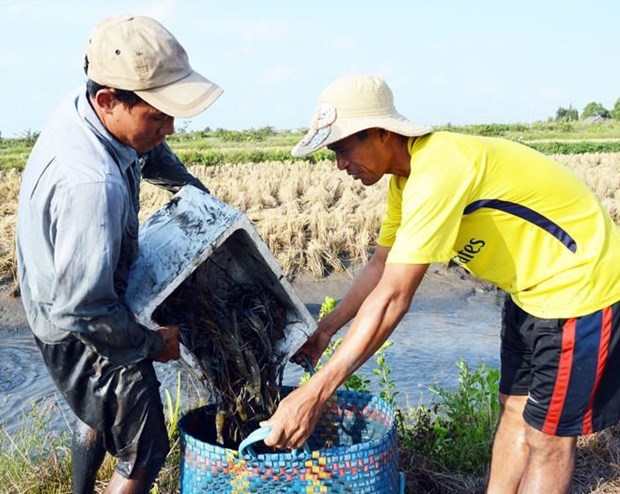
The Mekong Delta province of Ca Mau has managed to convert 30 out of 82 communes into new-style rural areas, an increase of 36.6 percent compared to 2010, heard a conference on October 8 to review 10 years of implementing the new-style rural area building programme in the locality.
On average, communes across the province completed13.65 of all 19 criteria for the programme, four times higher than in 2010.
As of 2018, per capita income in the province had reached 42 million VND (1,800 USD), doubling the figure in 2010, withthat of rural people hitting 29 million VND, higher than the average in the Mekong Delta region and the country.
Meanwhile, the ratio of poor households in the province fell to 4.04 percent.
By 2020, the province is striving to have one district recognised as a new-style rural area, along with three districts completing at least six criteria, half of the communes finishing all the criteria, and at least five communes becoming advanced new-style rural areas.
It expects each commune to fulfill 16.5 of the criteria on average, and per capita income at least 1.6 times higher compared to 2015.
Total investment in the programme by the province is targeted to reach over 1.27 billion VND(54,600 USD) in 2020.
Addressing the event, Deputy Secretary of the provincial Party Committee Pham Bach Dang lauded the efforts of localities across the province in implementing the programme in the 2010-2020 period.
However, he pointed out that the progress of the programme has been slower than the national and regional average. Meanwhile, the rural environment in many places is still polluted.
Dang asked for more efforts to complete the targets and tasks for the programme towards 2020 and 2025.
At the conference, delegates focused on seeking measures to mobilise resources for the programme and support the growth of agriculture and rural development.
On the occasion, the provincial People’s Committee presented certificates of merit to 27 individuals and 10 collectives for their outstanding performance in building new-style rural areas./.